A Study on the Enhanced Extraction of Ultra-High-Frequency Signals Induced by Transformer Core Coupling
Abstract
1. Introduction
2. Principle of Discharge Signal Induction by Transformer Core
2.1. Antenna Performance Parameters
2.2. Finite-Difference Time-Domain (FDTD) Method
2.3. Construction of Transformer Core Simulation Models
2.4. Simulation Study of Transformer Core Antenna Performance
2.5. Simulation Experiment on Signal Enhancement and Extraction
3. Experimental Validation of UHF Partial Discharge Detection via Transformer Core Grounding Current
3.1. Experimental Platform
3.2. Enhanced Detection Performance Test
3.3. Device Performance and Validation
3.3.1. Anti-Interference Performance Detection
3.3.2. Discharge Detection
4. Conclusions
- The transformer core model exhibits a voltage standing wave ratio below 5 within the UHF range, enabling effective PD detection as a UHF sensor in those bands.
- Adding a metal shielding layer outside the grounding bar significantly reduces signal transmission losses, improving the signal-to-noise ratio (SNR) of the detected signals.
- The UHF PD detection method based on transformer core-induced signals shows strong consistency with conventional pulse current and UHF detection techniques. The UHF signal amplitude can be reliably used to characterize discharge intensity.
Author Contributions
Funding
Data Availability Statement
Conflicts of Interest
Abbreviations
| PD | partial discharge |
| HFCT | high-frequency current transformer |
| UHF | ultra-high-frequency |
| DGA | dissolved gas analysis |
| VSWR | voltage standing wave ratio |
| ERP | effective radiated power |
| FDTD | finite-difference time-domain |
| SNR | signal-to-noise ratio |
References
- Zhao, T.; Feng, X.; Li, C.; Ma, J.; Sun, Y.; Guo, J. Partial discharge monitoring of commutation transformers based on high-frequency and ultra-high-frequency current monitoring of casings. Transformer 2020, 57, 33–37. [Google Scholar]
- Li, J.; Han, X.; Liu, Z.; Li, Y. Review of Partial Discharge Detection Technology in Electrical Equipment. High Volt. Eng. 2015, 41, 2583–2601. [Google Scholar]
- Du, H.; Cui, L.; Ao, M.; Wang, L.; Li, Y.; Lv, C. Design of denoising algorithm for 3D imaging system of transformer winding ultrasonic testing. High Volt. Eng. 2020, 46, 4376–4382. [Google Scholar]
- Ma, P.; Wang, Z.; Liu, Y.; Shen, P.; Wang, H.; Fu, X.; Yang, W. Partial discharge ultra-high frequency localization method for transformers based on IFA and TDOA. Comput. Appl. Softw. 2023, 40, 111–116. [Google Scholar]
- Su, Z.; Yu, R.; Zhang, Z. Partial discharge localization of transformers based on multiple polynomial results and double grid search. High Volt. Eng. 2024, 50, 1538–1547. [Google Scholar]
- Zhang, G.; Lu, C.; Zhou, H.; Tian, H.; Yu, X.; Zhang, X. Partial discharge ultrasonic and ultra-high frequency integrated sensing technology for power equipment. High Volt. Eng. 2022, 48, 5090–5101. [Google Scholar]
- Jia, Y.; Yang, J.; Gao, S.; Tao, F.; Liu, J.; Zhang, G. Design of PCB dipole antenna for partial discharge detection inside switchgear. High Volt. Appar. 2016, 52, 132–138. [Google Scholar]
- Yang, X.; Li, L.; Cheng, F.; Zhao, G.; Lei, B. Partial Discharge Pattern Recognition Based on FrFT Combined RVM. Guangdong Electr. Power 2024, 37, 95–103. [Google Scholar]
- Tenbohlen, S.; Jagers, J.; Vahidi, F. Standardized survey of transformer reliability: On behalf of CIGRE WG A2.37. In Proceedings of the 2017 International Symposium on Electrical Insulating Materials (ISEIM), Toyohashi, Japan, 11–15 September 2017; pp. 593–596. [Google Scholar]
- Yang, F.; Li, Y.; Lu, W.; Shi, H.; Li, Y.; Du, Z. Ultra high frequency signal monitoring method for partial discharge process of high voltage electrical equipment. Power Syst. Clean Energy 2022, 38, 55–60. [Google Scholar]
- Zhang, L.; Yang, J.; Jiang, C. Partial discharge location of power transformer based on UHF sensor and TDOA database. Transformer 2021, 58, 67–72. [Google Scholar]
- Xiao, Z.; Dong, M.; Deng, Y.; Ren, M.; Bi, J.; Yan, C. Simulation study on the selection of installation position for built-in ultra-high frequency sensors in transformers. Insul. Mater. 2014, 47, 76–81, 86. [Google Scholar]
- Chen, Y.; Ren, M.; Wang, K.; Guan, H.; Xia, C.; Wang, G. Simulation optimization of optical waveguide structure parameters for partial discharge detection. High Volt. Eng. 2023, 49, 5061–5072. [Google Scholar]
- Shen, Q.; Ni, Q.; Zhang, A.; Wang, K.; He, Z.; Sun, L. Case study of online monitoring of transformer oil chromatography in defect detection. Transformer 2024, 61, 72–75. [Google Scholar]
- Zhang, B.; Ma, Y.; Guan, R.; Bai, S.; Li, J.; Hu, W. Performance Optimization of ANN Method for Oil-filled Electrical Equipment Fault Diagnosis Based on DGA. Guangdong Electr. Power 2021, 34, 39–47. [Google Scholar]
- Guo, W.; Wang, Z.; Zhao, X.; Chen, G.; Xu, X.; Liu, Q.; Xie, X.; Chen, X. Review of Partial Discharge Detection Technology and Pattern Recognition of Oil-immersed Distribution Transformer. Guangdong Electr. Power 2023, 36, 67–78. [Google Scholar]
- Shen, Y.; Ruan, L.; Xie, Q.; Gao, S. On-site application of partial discharge detection of transformer using very wide bandwidth pulse current method. High Volt. Eng. 2011, 37, 937–943. [Google Scholar]
- Xu, C.; Xiao, R. Diagnosis and analysis of an internal discharge fault in large transformer. High Volt. Appar. 2010, 46, 67–69. [Google Scholar]
- Fu, J.; Yao, J. Fabrication and test of flexible microstrip antenna based on flexible PDMS. Transducer Microsyst. Technol. 2021, 40, 88–90. [Google Scholar]
- Li, Z.; Zang, Y.; Wang, C.; Tang, Y.; Ren, T.; Jiang, X. Analysis and diagnosis of optical and UHF partial discharges in GIS based on guided filtering fusion. IEEE Trans. Dielectr. Electr. Insul. 2025, 32, 2978–2985. [Google Scholar] [CrossRef]
- Cai, J.; Yuan, W.; Zhang, X.; Yang, Y.; Wu, J.; Li, J. Transformer partial discharge detection method based on UHF self-perception. High Volt. Eng. 2021, 47, 2041–2050. [Google Scholar]


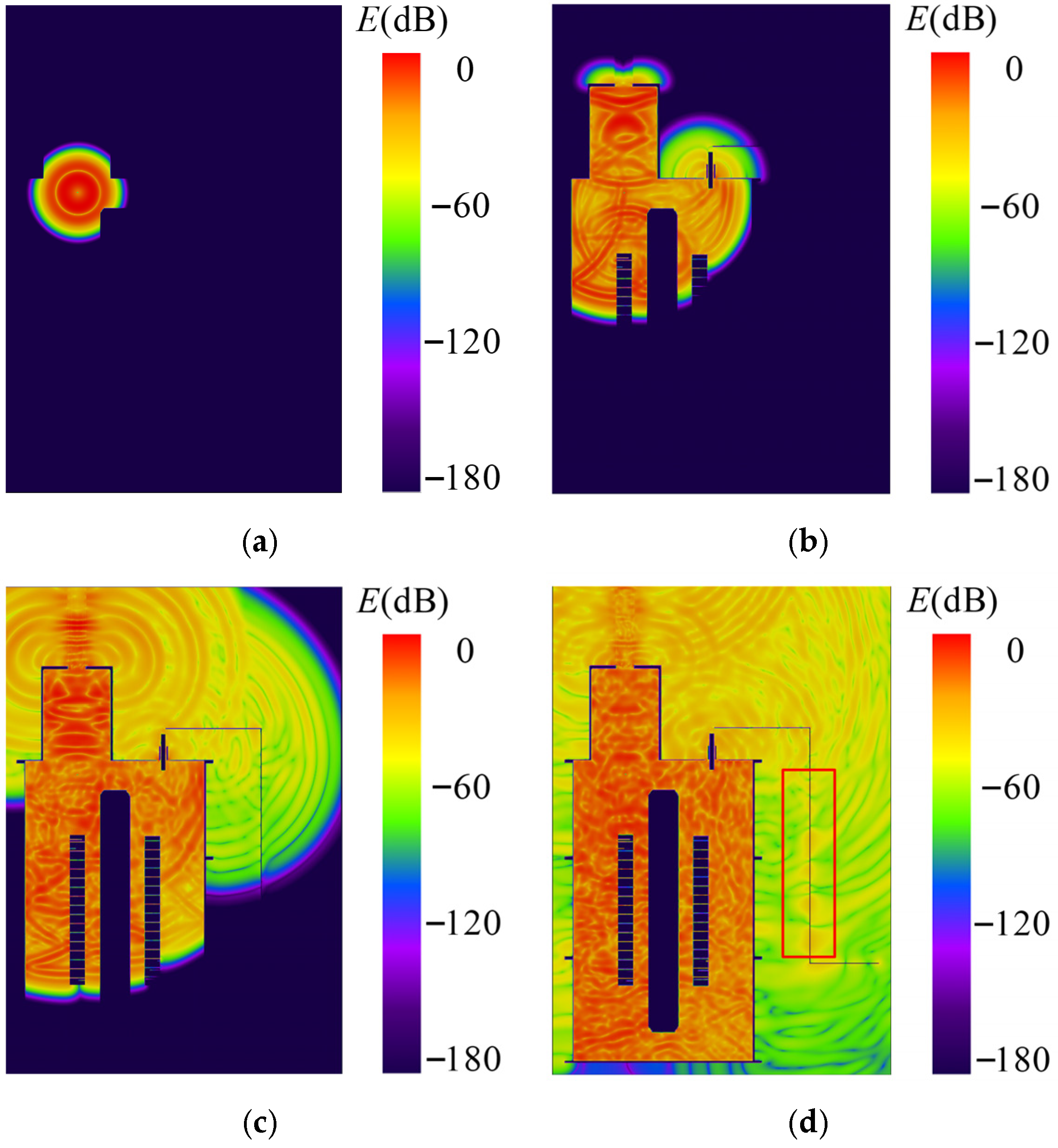
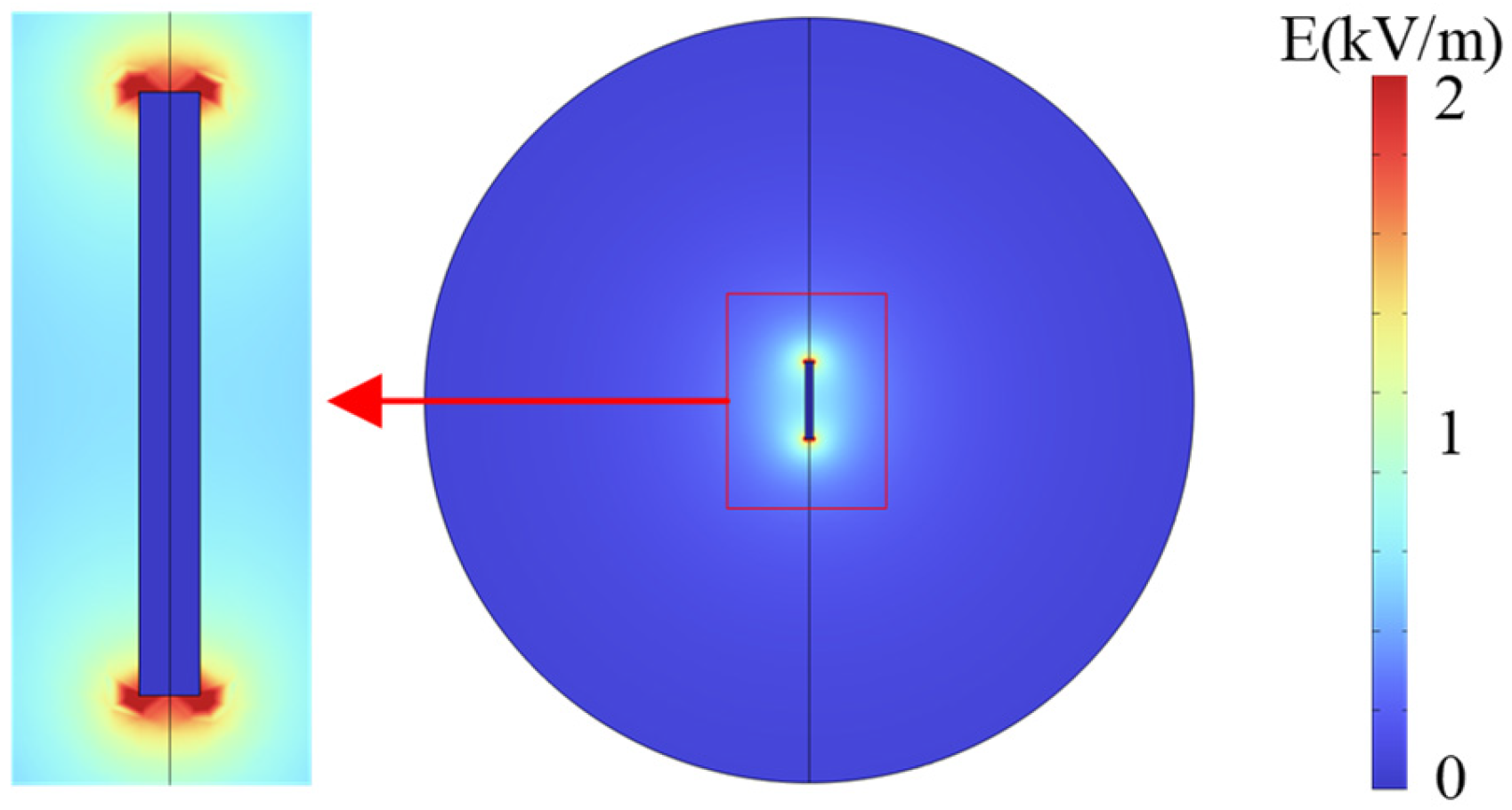



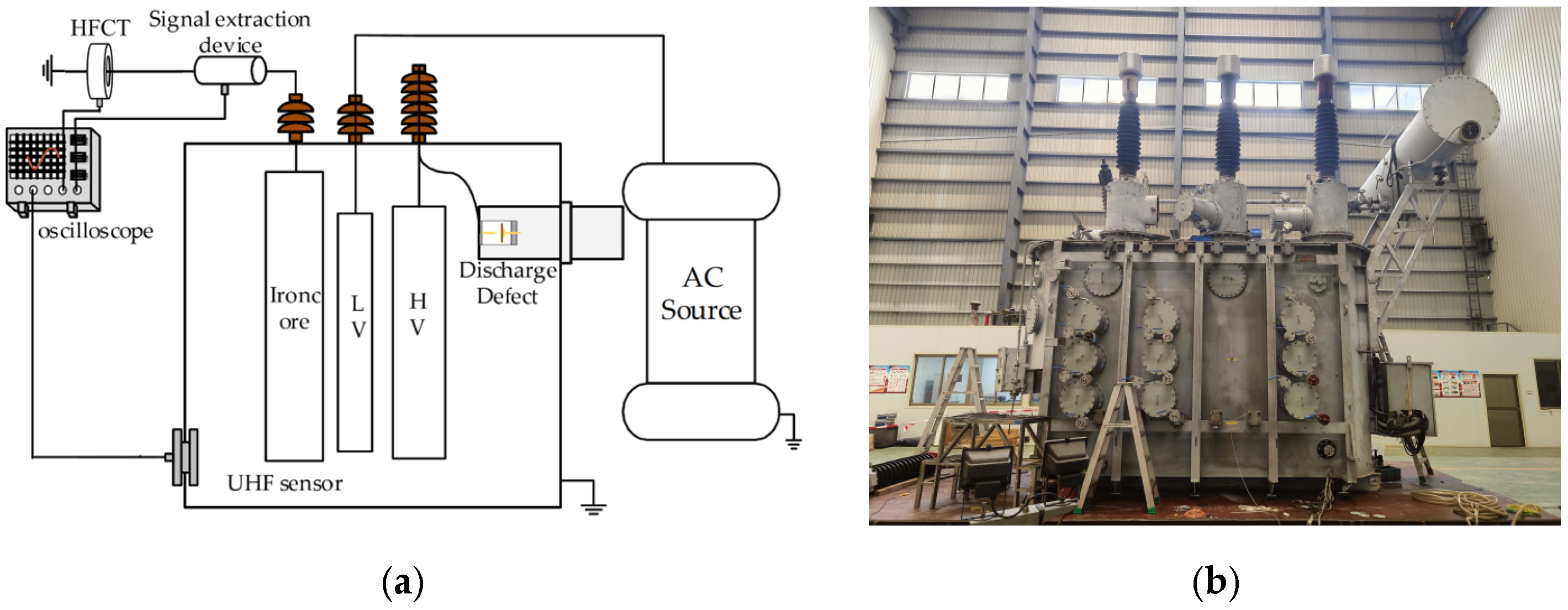
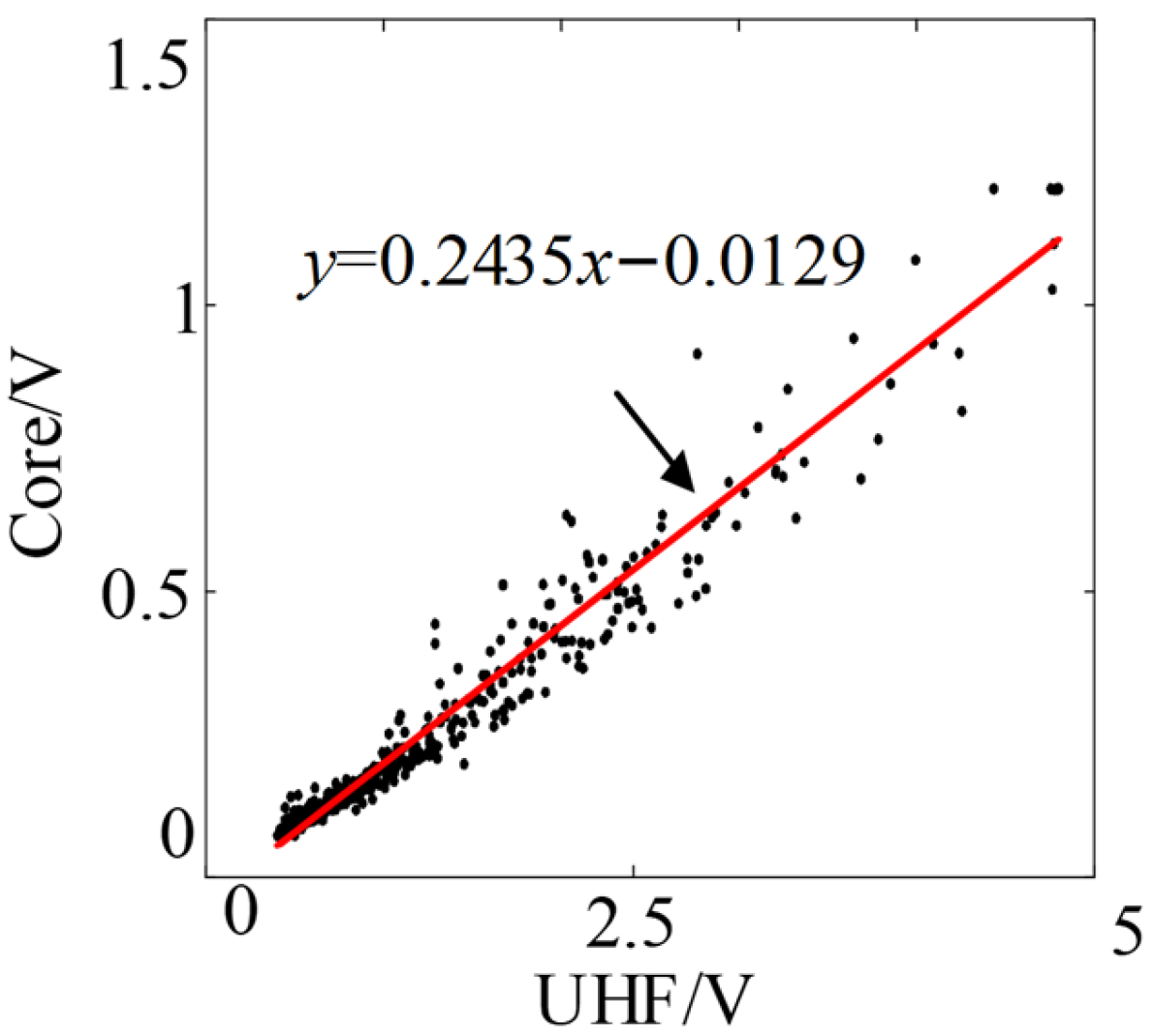

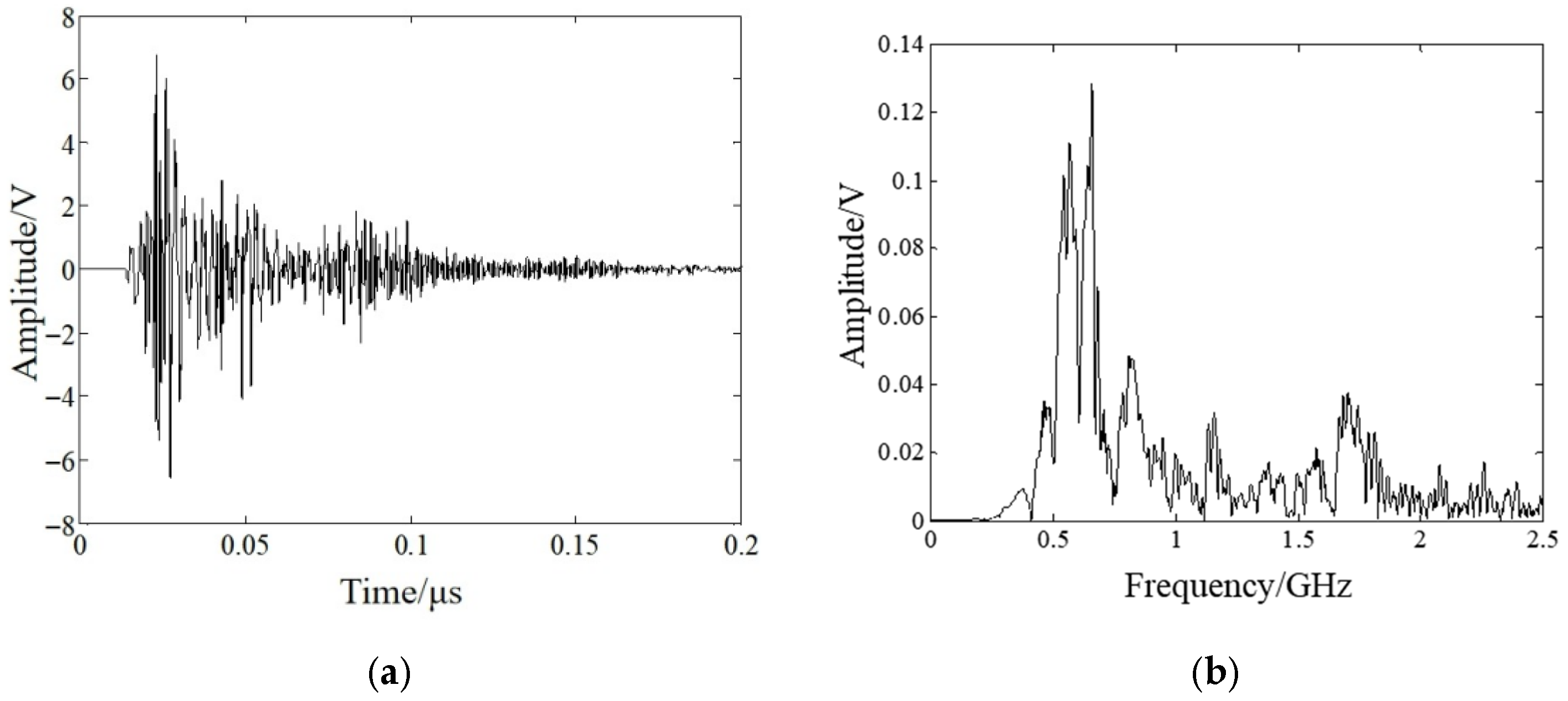


| Name | Conductivity (S/M) | Relative Permittivity |
|---|---|---|
| transformer oil | / | 2.2 |
| oil–paper insulation | / | 4.2 |
| core | 2 × 104 | / |
| winding | 5.8 × 107 | / |
| tank | 5 × 106 | / |
| lead rod | / | / |
| Name | Length | Width | Height | The Number of Silicon Steel Sheets |
|---|---|---|---|---|
| single-phase two-column core | 1110 mm | 346 mm | 1960 mm | 23 |
| three-phase three-column core | 2820 mm | 468 mm | 2115 mm | 27 |
| three-phase five-column core | 5716 mm | 863 mm | 2725 mm | 43 |
| Type | Reliable Detection Frequency Range |
|---|---|
| single-phase two-column core | 450–600 MHz, 1.4–1.6 GHz, 2.3–2.75 GHz |
| three-phase three-column core | 391–563 MHz, 1.34–1.51 GHz, 2.2–2.55 GHz |
| three-phase five-column core | 416–597 MHz, 1.48–1.54 GHz, 2.34–2.77 GHz |
| Name | Value | Name | Value |
|---|---|---|---|
| Inner diameter of the high-voltage winding | 879 mm | Length of tank | 4.2 m |
| Outer diameter of the high-voltage winding | 1011 mm | Width of tank | 1.8 m |
| Height of high-voltage winding | 935 mm | Height of tank | 2.3 m |
| Inner diameter of the low-voltage winding | 697 mm | Width of the grounding copper bar | 40 mm |
| Outer diameter of the low-voltage winding | 801 mm | Thickness of the grounding copper busbar | 4 mm |
| Height of low-voltage winding | 935 mm |
| Shielding State | Maximum Value | Mean Value | Fitted Function | Improvement Rate | ||
|---|---|---|---|---|---|---|
| UHF | Core | UHF | Core | |||
| unshielded condition | 4.6789 V | 0.6325 V | 1.2345 V | 0.1627 V | y = 0.1365x − 0.0058 | / |
| 12 cm | 4.9234 V | 1.2358 V | 1.8765 V | 0.4441 V | y = 0.2435x − 0.0129 | 78.39% |
| 16 cm | 4.5890 V | 1.2002 V | 1.4567 V | 0.3157 V | y = 0.2216x − 0.0171 | 62.30% |
| 20 cm | 4.5567 V | 0.9846 V | 1.5678 V | 0.3441 V | y = 0.2102x − 0.0154 | 53.99% |
| 26 cm | 4.8345 V | 0.7286 V | 1.6789 V | 0.2897 V | y = 0.1486x − 0.0098 | 8.86% |
| 31 cm | 4.9678 V | 0.4172 V | 1.3456 V | 0.1359 V | y = 0.0832x − 0.0061 | −39.05% |
Disclaimer/Publisher’s Note: The statements, opinions and data contained in all publications are solely those of the individual author(s) and contributor(s) and not of MDPI and/or the editor(s). MDPI and/or the editor(s) disclaim responsibility for any injury to people or property resulting from any ideas, methods, instructions or products referred to in the content. |
© 2025 by the authors. Licensee MDPI, Basel, Switzerland. This article is an open access article distributed under the terms and conditions of the Creative Commons Attribution (CC BY) license (https://creativecommons.org/licenses/by/4.0/).
Share and Cite
Ma, Z.; Cai, L.; Zhou, D.; Wen, A.; Jiang, S.; Lin, C.; Wang, Y. A Study on the Enhanced Extraction of Ultra-High-Frequency Signals Induced by Transformer Core Coupling. Energies 2025, 18, 5903. https://doi.org/10.3390/en18225903
Ma Z, Cai L, Zhou D, Wen A, Jiang S, Lin C, Wang Y. A Study on the Enhanced Extraction of Ultra-High-Frequency Signals Induced by Transformer Core Coupling. Energies. 2025; 18(22):5903. https://doi.org/10.3390/en18225903
Chicago/Turabian StyleMa, Zhiqin, Linglong Cai, Dan Zhou, Aihui Wen, Shuo Jiang, Chunyao Lin, and Yuan Wang. 2025. "A Study on the Enhanced Extraction of Ultra-High-Frequency Signals Induced by Transformer Core Coupling" Energies 18, no. 22: 5903. https://doi.org/10.3390/en18225903
APA StyleMa, Z., Cai, L., Zhou, D., Wen, A., Jiang, S., Lin, C., & Wang, Y. (2025). A Study on the Enhanced Extraction of Ultra-High-Frequency Signals Induced by Transformer Core Coupling. Energies, 18(22), 5903. https://doi.org/10.3390/en18225903





